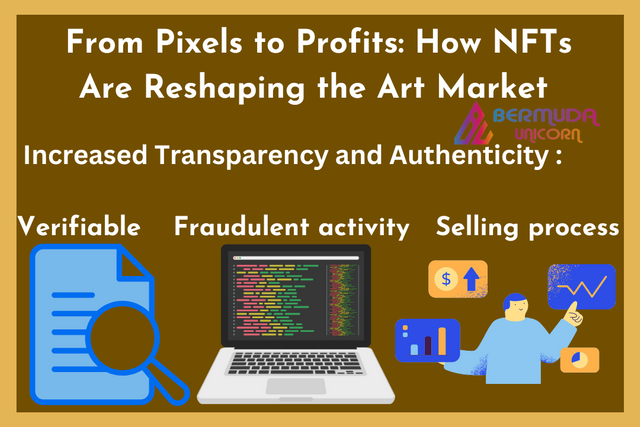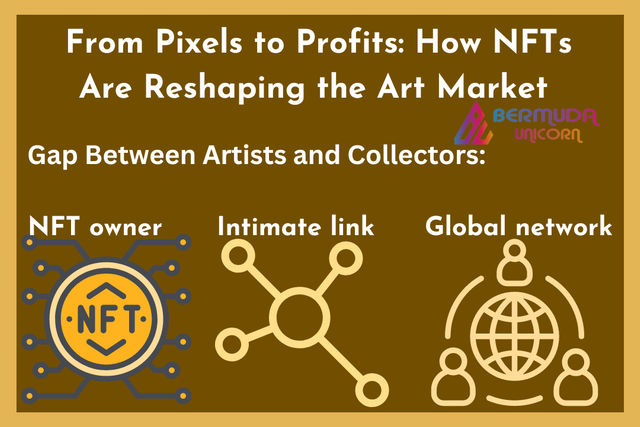Introduction :
With the rise of non-fungible tokens (NFTs), the art industry is experiencing seismic growth. These exclusive digital assets have transformed the art industry by providing artists with new opportunities for creation, ownership, and monetary success. In this blog, we will look at how unusual financial institutions (NFTs) are altering the art market and empowering artists, collectors, and art fans. NFTs are changing the way art is created, bought, and sold, from improved transparency and worldwide accessibility to expanded monetization potential. Join us as we explore the enormous influence of NFTs and the bright future they offer for the art world.
I. The Rise of Digital Art :
NFTs have sparked a renaissance in the realm of digital art, providing a platform for artists to showcase their creations in ways never before possible. By tokenizing digital artwork as NFTs, artists can establish verifiable ownership and scarcity in the digital space. This newfound ability to authenticate and sell digital art has unlocked a world of opportunities, empowering artists to monetize their work directly and receive royalties from secondary sales. NFTs have democratized the art market, allowing artists from all backgrounds to gain recognition and create unique pieces that resonate with collectors worldwide.
Digital art, once regarded as ephemeral, has now gained a sense of permanence through NFTs. Artists can create limited editions, unique series, or even a single masterpiece, each represented by an NFT. The blockchain technology underlying NFTs ensures the provenance and authenticity of each piece, providing a secure and transparent environment for both artists and collectors.
II. Increased Transparency and Authenticity :

NFTs leverage blockchain technology to provide unparalleled transparency and authenticity in the art market. Each NFT is associated with a unique digital signature stored on the blockchain, ensuring verifiable proof of ownership and immutable records of transactions. This transparency not only protects artists from fraudulent activity but also provides collectors with a clear and traceable ownership history. The elimination of intermediaries in the buying and selling process further enhances transparency and allows artists to have more control over their art and its value.
Additionally, the use of blockchain technology addresses the issue of forgery and ensures the uniqueness of each piece. Artists can now confidently sell digital art without fear of unauthorized reproductions or counterfeit copies. This assurance of authenticity adds value to the artwork and instills trust in collectors, as they can verify the origin and ownership of the NFT through the blockchain's transparent and immutable records.
III. Expanding Monetization Opportunities:
NFTs have transformed the art market by creating new monetization avenues for artists. Through the sale of NFTs, artists can directly connect with collectors and fans, eliminating the need for traditional galleries or agents. Additionally, NFTs enable artists to receive royalties on secondary sales, ensuring ongoing compensation for their creative endeavors. This innovative revenue model empowers artists to earn a fair share from the increasing value of their artwork over time.
NFTs have also expanded the concept of ownership beyond the physical realm. Collectors no longer need to possess physical artwork to own a valuable piece of art. Instead, they can own a digital representation of the artwork through an NFT, which grants them unique rights and proven ownership. The ability to trade and sell NFTs on various marketplaces provides artists with exposure to a global audience and the potential for increased profits.
IV. Bridging the Gap Between Artists and Collectors:

NFTs have established a direct and intimate link between artists and collectors. Artists can interact with their fans, create communities, and provide unique rewards and experiences to NFT owners. Collectors, on the other hand, can support their favorite artists while also gaining access to exclusive content and participating in the artist's career success. The NFT ecosystem has generated a spirit of collaboration and involvement that crosses borders, allowing artists to build global networks of supporters and admirers.
Moreover, NFTs have opened doors for artists from underrepresented communities to showcase their work and gain recognition. The decentralized nature of the NFT marketplaces allows artists to bypass traditional gatekeepers and establish direct relationships with collectors, breaking down barriers and fostering inclusivity within the art market.
Conclusion :https://bermudaunicorn.com/collection/pixel-paradox/
From pixels to profits, NFTs are revolutionizing the art market, empowering artists, and reshaping the way art is created, bought, and sold. NFTs' openness, authenticity, and enhanced monetization prospects have opened up a new world of possibilities for both artists and collectors. As the NFT space evolves, artists and art fans must embrace this disruptive technology and investigate the immense potential it has for the future of the art market. We can usher in a new era of artistic expression, ownership, and financial prosperity if we work together.